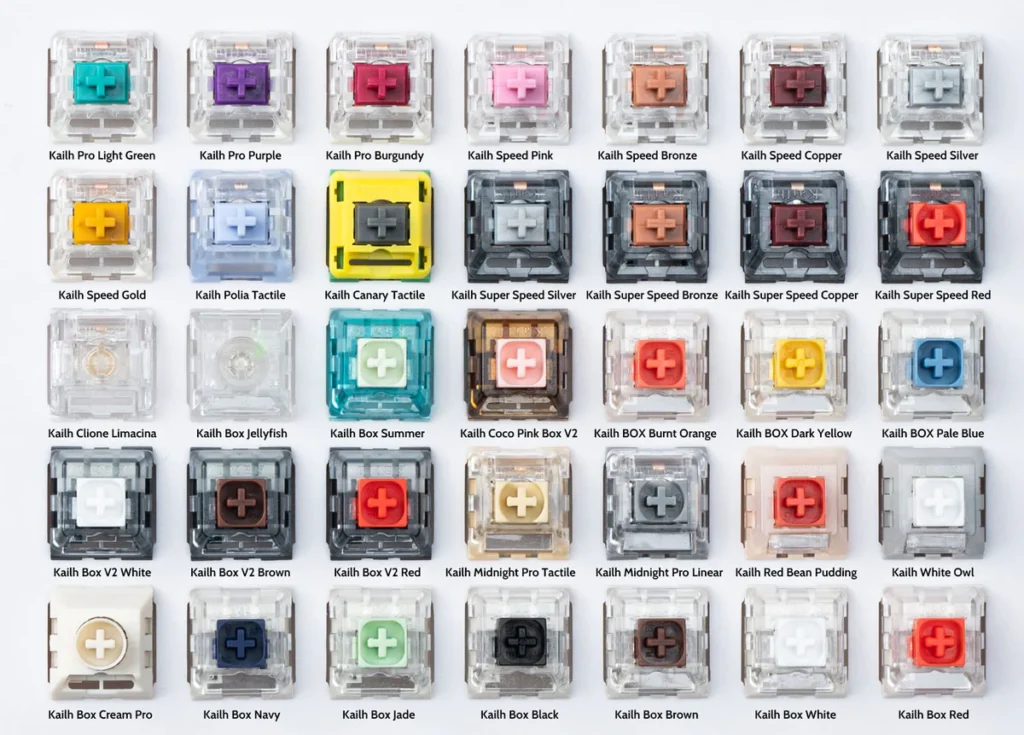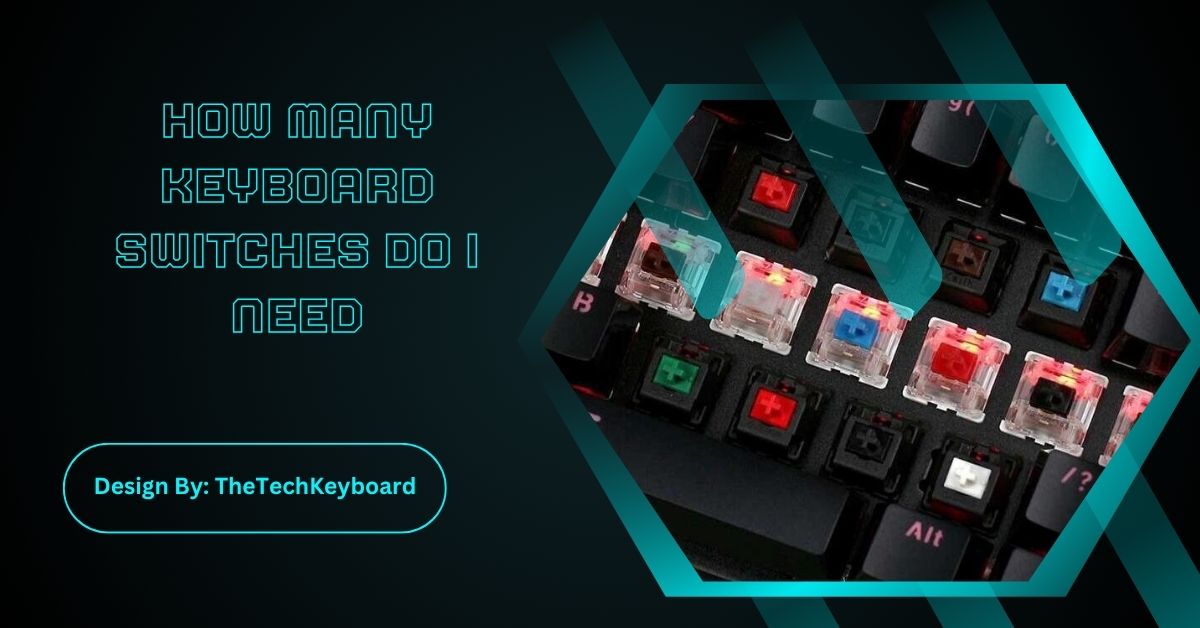The number of keyboard switches you need depends on your keyboard layout. For example, 60% boards need ~70 switches, while full-size keyboards require ~110–120. Always buy 10–15% extra switches.
If you’re diving into the world of mechanical keyboards, one of the first questions you’ll likely ask is: “How many keyboard switches do I need?” Whether you’re customizing a keyboard for gaming, work, or hobby purposes, knowing the number of switches you need is essential for budgeting and planning your build.
In this guide, we’ll walk you through everything—from keyboard layouts and switch counts to tips on buying and extras you should consider.
Understanding Keyboard Switches

Mechanical keyboard switches are the heart of your keyboard. Each key typically has one mechanical switch underneath it, responsible for how the keystroke feels and sounds.
Common switch types include:
- Linear (e.g., Cherry MX Red) – Smooth keystroke with no tactile bump.
- Tactile (e.g., Cherry MX Brown) – Noticeable bump for feedback.
- Clicky (e.g., Cherry MX Blue) – Tactile bump with an audible click.
Choosing the right type of switch is one thing—but knowing how many you need is another. That depends entirely on the layout and design of your keyboard.
Common Keyboard Layouts and Switch Counts
Keyboard switch requirements depend on your layout. Here are the most common keyboard sizes with estimated switch needs:
| Keyboard Size | Number of Keys | Number of Switches Needed |
| 60% Keyboard | 61 keys | 65–70 switches |
| 65% Keyboard | 67–68 keys | 70–75 switches |
| 75% Keyboard | 80–84 keys | 85–90 switches |
| Tenkeyless (TKL) | 87 keys | 90–95 switches |
| Full-Size Keyboard | 104–108 keys | 110–120 switches |
| 1800-Compact Keyboard | 96–99 keys | 100–105 switches |
| Alice or Ergodox Layout | 60–70 keys | 70–90 switches |
| Macropads & Custom Kits | Varies | 10–40 switches (or more) |
💡 Tip: Always buy extra switches (10–15% more) in case of defects, testing, or future replacements.
Why You Should Buy Extra Switches?
Even if your layout only requires 87 switches, it’s wise to order extra for several reasons:
- Defective Switches: Manufacturing defects can happen.
- Mistakes During Assembly: Soldering errors or bent pins are common.
- Future Replacements or Mods: Hot-swappable boards make it easy to change switches later.
- Consistency: Buying from the same batch helps maintain sound and feel consistency.
Example: For an 87-key TKL board, ordering 100 switches is ideal.
How to Calculate Your Switch Count?
Here’s a simple way to calculate how many switches you need:
- Determine Your Layout (60%, TKL, Full-size, etc.)
- Count the Keys in your keyboard layout.
- Add 10–15% Extra to your total for safety.
Formula:
(Total Key Count) + (10–15% extra) = Total Switches to Buy
Example:
TKL Layout = 87 Keys
87 × 1.15 = ~100 Switches
Hot-Swappable vs. Soldered: Does It Matter?
Yes, it does.
- Hot-swappable keyboards let you change switches without soldering. This makes it easy to test different switches, so having more on hand is useful.
- Soldered keyboards require more careful planning, as removing and replacing switches later can be more difficult.
Recommendation: For hot-swappable builds, buy extra to experiment and rotate. For soldered builds, double-check your count before assembly.
Where to Buy Mechanical Keyboard Switches?
Here are some reliable sources to buy your switches:
- Online Retailers: Amazon, Drop, MechanicalKeyboards.com
- Keyboard Vendors: NovelKeys, KBDfans, CannonKeys, Divinikey
- Local Sellers: Check keyboard community groups or marketplaces
- Group Buys: Ideal for limited edition switches, though slower delivery
Sound and Feel Matter: Mix & Match Options
Some keyboard builders like to use different switches for different rows or functions. For example:
- Tactile on Alphas (typing keys)
- Linear on Spacebar or Gaming Keys
- Clicky on Function Keys
This approach means you might want small packs of multiple switch types, increasing your total count.
Keyboard Kits with Switch Recommendations

If you’re buying a DIY kit, many vendors list the number of switches required:
- Tofu60 by KBDfans: Needs 61–65 switches
- GMMK Pro by Glorious: Needs 83–84 switches
- Keychron Q6 (Full Size): Requires 108 switches
Always check the kit’s documentation or ask the vendor for confirmation.
Additional Considerations
- Switch Lubing: If you’re lubing your switches, having extras helps if you over-lube or damage one.
- Budget Planning: Switch prices range from $0.30 to $1.20+ per switch, depending on brand, quality, and features. Bulk buying often gives better rates.
- Switch Testing: Buy a switch tester to try different types before committing to a full batch.
Final Summary Table
| Layout | Switches Needed | Recommended Purchase |
| 60% | 61 | 70–75 |
| 65% | 67–68 | 75–80 |
| 75% | 80–84 | 90 |
| TKL (Tenkeyless) | 87 | 100 |
| Full-size | 104–108 | 110–120 |
FAQs:
1. Why do I need extra keyboard switches when building a custom board?
Extra switches help cover defective units, assembly mistakes, and future replacements. It’s smart to buy 10–15% more to ensure smooth building, especially for soldered or custom layout keyboards.
2. How many switches does a Tenkeyless (TKL) keyboard need?
A TKL layout has around 87 keys. For safe building and testing, it’s recommended to buy about 100 switches. The extra ones cover errors, mods, or future switch changes.
3. Can I mix different switch types in one keyboard?
Yes, many users combine switches based on use. For example, linear switches for gaming keys and tactile ones for typing. Mixing gives a custom feel tailored to your typing style.
4. Do hot-swappable keyboards require more switches than soldered ones?
Not necessarily more, but hot-swap boards encourage experimenting with different switches. So, buying extras is useful for testing and rotating different types without permanent installation.
5. What happens if I run out of switches during assembly?
If you don’t have enough switches, you’ll have to reorder and delay your build. This is why ordering extra upfront ensures you finish your build without interruptions or mismatched batches.
Conclusion:
Knowing how many keyboard switches you need is key to a successful custom build. Whether you’re building a 60%, TKL, or full-size keyboard, the number of switches depends on layout, features, and custom preferences. Adding 10–15% extra switches ensures flexibility, avoids build interruptions, and helps with future modifications. Switch count planning saves you money, time, and stress. Make sure to research your specific layout and always buy from reliable vendors to guarantee a smooth and satisfying keyboard-building experience.
Related Post:
- Reid Russom – Purpose-Driven Educator and Leader!
- Numa Zara – Digital Fashion Revolution Blending Identity!
- Ecryptobit – Buy, Sell & Secure Digital Assets!
- Long Shooter – From Idioms and Film!
- Kick Flipper – Best Indoor Practice Board!
- Shannon Reardon Swanick – Leader Who Inspires Change!
- Serumcu – Eco-Friendly Cleaner for Stains and Odors!
- Nucleuscoop Keyboard Not Working – Causes, Fixes & User Guide!
